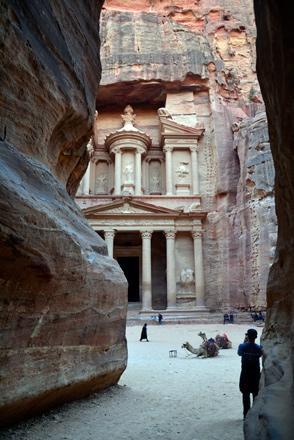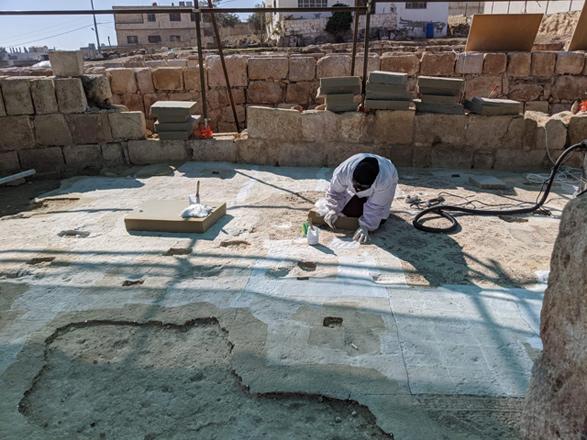You are here
UNESCO project engages local communities, Syrian refugees in heritage preservation
By Saeb Rawashdeh - Sep 06,2022 - Last updated at Sep 06,2022

One of UNESCO workers is seen preserving mosaic floors from the Byzantine era, approximately 6th century AD in Rihab, Mafraq (Photo courtesy of UNESCO)
IRBID — The UNESCO Jordan Office is implementing a project that engages local communities and Syrian refugees in the preservation of six cultural heritage sites in the northern districts of Irbid and Mafraq. The project will also develop the sites for tourism, noted Giorgia Cesaro from UNESCO Office in Amman.
Cesaro’s remarks came during the 15th International Conference on the History and Archaeology of Jordan held at Yarmouk University last month.
“The project, financed through the European Union Regional Trust Fund for the Syria Crisis, contributes to building economic resilience among refugees and host communities through the application of employment-intensive schemes for the safeguarding and rehabilitation of cultural heritage sites,” Cesaro said.
This approach was developed by the International Labour Organisation to ensure employment that respects fundamental human rights as well as the rights of the workers, she said,
Cesaro noted that the project’s methodology focuses on the role of culture as a vector for socioeconomic development, detailing how the active involvement of communities in heritage preservation and presentation can be both a driver of social cohesion, and an asset to site conservation.
Skill development is also an essential component of the project. Local skilled and unskilled labourers are trained on the job, while young graduates receive a more structured training, Cesaro continued.
Results from the projects undertaken at the sites of Umm Qais and Um es-Surab, in collaboration with the German Protestant Institute of Archaeology and the Institut Français du Proche Orient, will be presented as best practices for replication at other sites in Jordan or the region, the UNESCO official said.
The initiative addresses the widespread unemployment in the country, while at the same time contributing to the preservation and presentation of Jordanian heritage sites and boosting the local economy, Cesaro said.
“The benefit of this approach is that it can be identified in terms of the assets and services that are targeted,” she said.
Heritage conservation is normally associated with construction work, a domain where women are usually excluded. In this project, however, there are several activities women can take part in, she said, adding that an objective of the project is to engage women as much as possible.
“The workers are divided into different categories: The majority being unskilled workers, then follow the skilled workers, who normally have previous experience in construction work, but less so with regard to conservation,” she said.
Cesaro said that the sought-after skills associated with the project include experience in heritage conservation, renovation, mosaic restoration and landscaping.
“The objective of the project is to preserve the sites and employ the people that live nearby. The project also tends to demonstrate that unskilled people without prior knowledge of neither heritage management nor conservation can learn simple skills, which can greatly contribute to the longer term preservation of the sites, representing a crucial resource in the future for the DoA [Department of Antiquities] and any other stakeholder involved in the preservation of Jordan’s heritage,” Cesaro said.
Related Articles
AMMAN — UNESCO project “Employment Opportunities for Cultural Heritage Safeguarding in Jordan” aims to invest in cultural heritage preservat
AMMAN — After a busy morning of work along the back-trail to the Monastery in Petra, Yousef Ahmed Hasanat took a break in the shade to share
AMMAN — In the hills of Rihab, a village a few kilometres away from Mafraq, the remains of several ancient churches can be found, each with



















